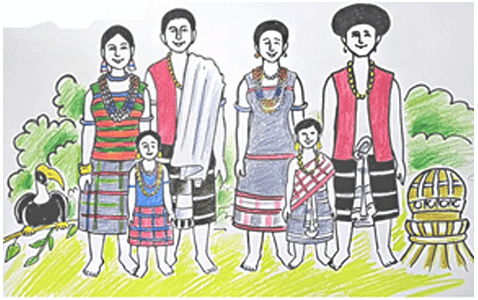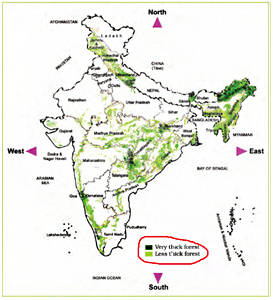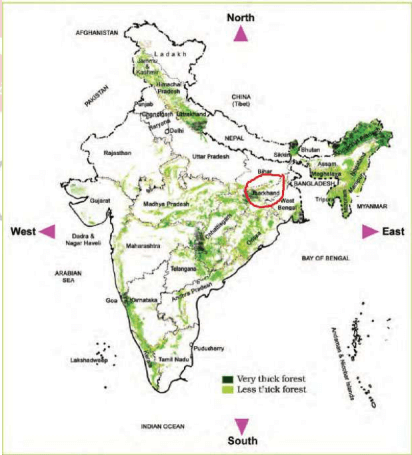NCERT Solutions for Class 5 EVS Chapter 20 - Whose Forests
Class 5 EVS Chapter 20 introduces the concept of forests and describes the inter-relationship among plants, animals, and humans living in a forest and its adjoining areas. The chapter narrates the lives of forest-dwellers and their relationship with the forest, and how activities like the construction of highways, bridges, etc., are adversely affecting forests. Some other topics mentioned in the chapter Whose Forests Class 5 EVS are medicinal and commercial plants, important forest regions of India, and farming techniques used in north-eastern states of India like jhoom cultivation. The NCERT textbook (Looking Around) questions are answered in a simple and engaging manner. We also have related ‘Learning Concepts’, and interactive worksheets with solutions. Our ‘Learning Beyond’ segment caters to all the probable questions that the child might think out of curiosity. Download Chapter 20 Whose Forests? in the PDF format for free.
Download PDF For NCERT Solutions for EVS Whose Forests
The NCERT Solutions for Class 5 EVS Chapter 20 - Whose Forests are tailored to help the students master the concepts that are key to success in their classrooms. The solutions given in the PDF are developed by experts and correlate with the CBSE syllabus of 2023-2024. These solutions provide thorough explanations with a step-by-step approach to solving problems. Students can easily get a hold of the subject and learn the basics with a deeper understanding. Additionally, they can practice better, be confident, and perform well in their examinations with the support of this PDF.
Download PDF
Access Answers to NCERT Solutions for Class 5 EVS Chapter 20 - Whose Forests
Students can access the NCERT Solutions for Class 5 EVS Chapter 20 - Whose Forests. Curated by experts according to the CBSE syllabus for 2023–2024, these step-by-step solutions make EVS much easier to understand and learn for the students. These solutions can be used in practice by students to attain skills in solving problems, reinforce important learning objectives, and be well-prepared for tests.
Discuss
Bhudhiyamai said— “Forest is our ‘collective bank’—not yours or mine alone”. Are there other things which are our collective wealth? So, if someone uses more, everyone would suffer?
All natural resources available are for everyone and must be used judiciously. Exploiting natural resources would affect everyone’s lives, including our future generations. Some examples of collective wealth are—
i) Coal and petroleum, ii) Seafoods like fish, crabs, and prawns, iii) Groundwater, iv) Minerals.
What do you think is a forest?
An area covered with different plants including trees, shrubs and bushes is called a forest. One can see various types of plants, birds, insects, and animals in a forest.
If someone grew lots of trees close to each other, would this become a forest?
No, growing many trees close to each other does not make a forest. A forest is a thick cover of plants that takes many years to form.
Who do you think the forest belongs to?
Forests belong to everyone, including man, animals, birds, insects, because these are not anyone’s personal property.
Find Out and Write
Other than trees what all is there in a forest?
Other than trees, the forest is home to various animals, insects, birds and microorganisms.
Suryamani says, “If the forests are not there, we too will not remain”. Why so?
Humans depend on forests for various reasons because of the following reasons—
i) Plants give off oxygen and absorb carbon dioxide. We know oxygen is essential for the sustenance of life. Thus, forests act as a balancing agent of the environment and also plays the role of a natural air purifier.
ii) Forests are the sources of food, medicinal herbs, different raw materials like wood that humans use in different ways.
iii) Forests provide a source of livelihood for the people residing near them.
iv) Forests are the natural habitat of many animals, birds and insects. Without forests, they will not have a place to stay and will start to encroach on human settlements for their survival.
So based on the above points, we can say that forests play a significant role in the existence of human life.
Do all forests have similar types of trees? How many trees can you identify?
The environmental factors of the region impact the type of trees that grow in the forests of those regions. Hence, one can find different kinds of trees in different forests. I can identify the following trees— i) Mango, ii) Coconut, iii) Gulmohar, iv) Neem, v) Sheesham, vi) Banyan, vii) Teak, viii) Eucalyptus. [Students should mention their experience based on the above lines.]
Think and Write
Is there any place around your area which you feel should be open to everyone, but where people are not allowed to go?
There is an old palace in my town. It is neither open for common people nor maintained well by the authorities. I feel it should be renovated by the authorities and should be open to the common people.
[Students should mention their experience based on the above lines.]
Some people have moved so far away from the forest that they cannot understand the lives of forest people. Some even call them ‘jungli’. Why is it not correct to say this?
Using the word jungli seems disrespectful. The choices, habits, rituals, festivals, and lifestyles of people depend on the geographical location. Dwelling near forests does not make people jungli. Instead, they respect forests and take care of them. They work hard and honestly earn their living.
Do you have a friend with whom you can share everything?
Yes, Avantika is my best friend with whom I share everything.
[Students should mention their experience based on the above lines.]
The contractor did not allow Suryamani’s people to go into the forest. Why?
The contractor cut wood from the forest for commercial purposes, so he did not allow Suryamani to go into the forest.
Do you know anyone who loves the forest?
Yes, I and my father are fond of forests. We go to different forests and enjoy jungle safaris during our vacations.
[Students should mention their experience based on the above lines.]
Discuss and Tell
What do you know about how adivasis live? Write and draw a picture.
Adivasis are simple people who depend on forests for their food. They have simple style of wearing clothes. In some areas, one can find them wearing animal skins. They have different festivals, languages and cultures. They do not like the interference of outsiders in their living places or lives. They worship different elements of nature as they value the importance of natural resources.

Do you have an adivasi friend? What have you learnt about the forest from her?
Yes, I have an adivasi friend in school, and her name is Jamuna. Since she has spent a long time in the forests, she knows many things about them. She can identify plants by looking at their leaves and understands the benefits of medicinal plants. I have learnt the use of natural herbs in daily life from her. For example, using neem in hot water keeps our skin clean, and harshringar is used to relieve joint pains.
[Students should mention their experience based on the above lines.]
Think
In ‘Torang’ Suryamani does a lot to keep the Kuduk music, dance and traditions alive. Would you like to do something like this for your community? What would you like to keep alive?
Yes, I would like to keep the following things alive in my culture—
i) Rajasthani folk music and dance.
ii) The traditional Rajasthani attire of ghagra, choli and odhni.
[Students should mention their experience based on the above lines.]
What is your dream? What will you do to make your dream come true?
I want to become a pilot. I will study hard to make my dream come true.
Collect reports about forests from newspapers. Did you find any news about how cutting down of forests affects the weather? How?
.png)

I have come across news articles that state that how global warming has led to climate change. Deforestation i.e., cutting down forests is one of the major causes of global warming. Extensive deforestation causes an increase in carbon dioxide concentration in the atmosphere, facilitating global warming, thereby affecting the weather patterns.
i) The rainfall pattern is becoming erratic.
ii) Frequent occurrence of cyclones.
iii) Extreme hot summers.
iv) Occurrence of droughts.
[Students should mention their experience based on the above lines.]
Do you know of anyone who works to save forests?
Yes, there is a small group in our locality, and they work to maintain a small patch of forest near our city. They organise awareness camps, tree plantation drives and forest cleaning programmes.
[Students should mention their experience based on the above lines.]
Read and Tell
Sikhya, a Class X girl in Odisha, wrote a letter to the Chief Minister. Read a part of the letter.
Due to the factory is there any effect on the trees and the land? Have the people in that area raised this issue?
Due to the construction of the industrial complex, the following difficulties have arisen—
i) A patch of land with many trees has been cleared. A waterbody, too, has been filled up.
ii) The air quality has degraded.
iii) One gets the pungent smell of ammonia in the early mornings.
Yes, the people residing there are not aware of the harmful effects of such construction work, and so they have not raised any issue.
[Students should mention their experience based on the above lines.]
Is there any factory or some construction work going on in and around your area? What type of work?
An industrial complex is being built on the outskirts of my city. A lot of construction work is going on for this reason.
[Students should mention their experience based on the above lines.]
Look at the Map and Write
How can you find out which states have very thick forests and which have less thick forests?
We can find this by looking at the key. The dark green colour indicates the thick forest cover, and the light green colour shows a thin forest cover.

Where is Suryamani’s state Jharkhand on the map?
Jharkhand is situated towards the south of Bihar and north of Orrisa.

Where are forests on the map? How will you find these?
The forests are represented by a green colour on the map and are visible in some states of India. A key for the same is mentioned in the bottom right position of the map.
What all is shown in the map?
The map shows the distribution of forest cover in our country.
Is there a sea close to Orissa? How did you find out?
The Bay of Bengal Sea lies on the eastern side of Orrisa. It is marked on the map.
Which are the states which have sea on one side?
The following states have the sea on one side—
i) Karnataka, ii) Goa, iii) Maharashtra, iv) Gujarat, v) Kerala, vi) Tamil Nadu, vii) Andhra Pradesh, viii) Orrisa, ix) West Bengal.
For someone in Madhya Pradesh, in which direction would the country’s thickest forests be? Name those states.
For someone in Madhya Pradesh, the country’s thickest forest would be towards the north, east and north-east. The states with the thickest forests are as follows— Chhattisgarh, Uttarakhand, Arunachal Pradesh, and Jharkhand.
You have read Sikhya’s letter. Look for Orissa in the map.
Orissa is in the eastern coastal part of India. It is surrounded by Chhattisgarh, West Bengal, Andhra Pradesh and Jharkhand.

Find Out
Have you ever seen anything which people are free to use, with no one there looking after it?
Yes, there are many things in public places that people are free to use like water dispensers, public toilets etc.
Chamui said they measure land using tin. Which are the other ways of measuring land?
Other ways of measuring land are—i) square metres, ii) Bigha, iii) Acre, iv) Katha, v) Yard, vi) Hectare
Which are the states around Mizoram?
The states around Mizoram are—Manipur, Nagaland, Tripura, Meghalaya.
Find out more about ‘cheraw’ dance. Do it in your class. But be careful and don’t hurt yourself.
‘Cheraw’ is a famous traditional dance of Mizoram. The dancers use bamboo staves to set a rhythm for dancing. Four to six people hold the long bamboos across one another on the ground, and the female dancers weave in between the bamboos on the rhythm. Their dance movements reflect the swaying of trees and the flight of birds. They wear colourful costumes, which adds to the beauty of the dance. Cheraw is gradually gaining fame globally. In 2010, this dance form was featured in the Guinness Book of World Records.

Returning from school, children drank water in a bamboo cup. Who do you think would have made this cup and kept it in the forest? Why?
The adivasis must have made those cups. They must have been selling those cups to earn money. Also, they must have kept it in the middle of the roadways to be used by people passing by for drinking water.
What We Have Learnt
What is similar and what is different between Jhoom farming and Bhaskarbhai’s way of farming?
Similarities:
Both types of farming are based on the use of natural manure to maintain soil fertility and get a good crop yield.
Differences:
| Bhaskarbhai’s way of farming | Jhoom Farming |
|---|---|
| Bhaskarbhai used dried leaves, peels of vegetables and fruits, and leftover food to prepare manure by composting. | Here the manure is prepared by burning the weeds and other plants growing on the patch of land. |
| He used earthworms to fasten the process of composting. | No earthworms were used. |
| He grew a variety of crops. | Rice is the major crop grown. |
| The same patch of land is used for cultivation. | After a cropping season, the patch of land is left uncultivated to replenish soil nutrients. |
Explain in your own words why forests are important for the people living in forests.
The following reasons distinguish Jhoom farming from other types of farming—
i) A new patch of land is used in every cropping season.
ii) This type of farming allows the soil to replenish its fertility.
iii) The weeds and unwanted plants are not removed; rather, they are used as manure.
Frequently Asked Questions
The NCERT solution for Class 5 Chapter 20: Whose Forests is important as it provides a structured approach to learning, ensuring that students develop a strong understanding of foundational concepts early in their academic journey. By mastering these basics, students can build confidence and readiness for tackling more difficult concepts in their further education.
Yes, the NCERT solution for Class 5 Chapter 20: Whose Forests is quite useful for students in preparing for their exams. The solutions are simple, clear, and concise allowing students to understand them better. They can solve the practice questions and exercises that allow them to get exam-ready in no time.
You can get all the NCERT solutions for Class 5 EVS Chapter 20 from the official website of the Orchids International School. These solutions are tailored by subject matter experts and are very easy to understand.
Yes, students must practice all the questions provided in the NCERT solution for Class 5 EVS Chapter 20: Whose Forests as it will help them gain a comprehensive understanding of the concept, identify their weak areas, and strengthen their preparation.
Students can utilize the NCERT solution for Class 5 EVS Chapter 20 effectively by practicing the solutions regularly. Solve the exercises and practice questions given in the solution.

